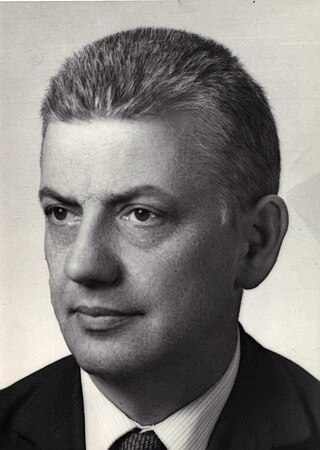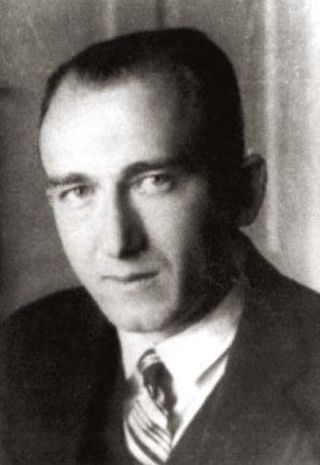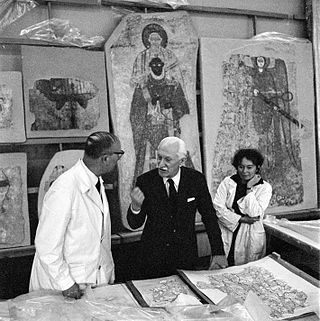
Grudziądz is a city in northern Poland, with 92,552 inhabitants (2021). Located on the Vistula River, it lies within the Kuyavian-Pomeranian Voivodeship and is the fourth-largest city in its province. The Old Town of Grudziądz and 14th-century granaries were declared National Historic Monuments of Poland.

Turek is a town in central Poland with 31,282 inhabitants as of 2009. It is the capital of Turek County in the Greater Poland Voivodeship. It is located in the Sieradz Land.

Biskupin is an archaeological site and a life-size model of a late Bronze Age fortified settlement in north-central Poland that also serves as an archaeological open-air museum. When first discovered it was thought to be early evidence of a West Slavic settlement, but archaeologists later confirmed it belonged to the Biskupin group of the Lusatian culture from the 8th century BC. The excavation and the reconstruction of the prehistoric settlement has played an instrumental part in Polish historical consciousness.

Wanda Wasilewska, also known by her Russian name Vanda Lvovna Vasilevskaya, was a Polish and Soviet novelist and journalist and a left-wing political activist.

Jacek Maria Dehnel is a Polish poet, writer, translator and painter.

Henryk Zieliński was a Polish historian and professor at the University of Wrocław.

Jan Marcin Szancer was a Polish illustrator, scenographer and professor at the Academy of Fine Arts in Warsaw.
Schutzmannschaft Battalion 202 was a failed collaborationist auxiliary police battalion in the General Government during World War II. It was made up of 360 conscripts with German leadership. The unit was created in Kraków on March 27, 1942 with recruitment beginning in May. Only two Polish men volunteered. As a result, the Germans resorted to conscription from the regular Polish city-police called Einheimische Polizei. Once in Volhynia, the battalion stationed in Łuck originally. Soon later, in around Kostopol, half the members deserted to Polish resistance 27th Home Army Infantry Division, in defence of ethnic Polish population against the UPA massacres, and also committed a number of crimes against the civilian population, participating in the pacification of Ukrainian villages. Additional 60 Poles were rounded up and executed by the Nazis for mutiny.

Jerzy Borejsza was a Polish communist activist and writer. During the Stalinist period of communist Poland, he was chief of a state press and publishing syndicate.

Janina Broniewska née Kunig was a Polish writer, author of many stories for children and young adults, a publicist and teacher. She subscribed to radically leftist views and became a communist activist, writer and official.

Stańczyk is a painting by Jan Matejko finished in 1862. This painting was acquired by the Warsaw National Museum in 1924. During World War II it was looted by the Nazis, but later seized by the Soviet Union and returned to Poland around 1956.

The Battle of Grochowiska took place on 18 March 1863 at the village of Grochowiska near Pińczów, Poland during the Polish January Uprising against the Russian Empire. It involved a 3,000-strong unit of Polish insurgents under the command of Marian Langiewicz which had been cornered by Russian forces numbering around 3,500 soldiers and six artillery pieces. It was one of the most bloody, as well as one of the largest battles of the Uprising.
During the Polish–Soviet War fought from February 1919 to October 1920 between Soviet Russia and the Second Polish Republic – in the aftermath of World War I in Europe – the Polish order of battle included broad disposition of personnel, strength, organization, and command structure.

Rzeczpospolita Polska was the official monthly underground journal and mouthpiece of the Government Delegation for Poland, the highest authority of the Polish Underground State, accountable to the Polish government-in-exile located in London during the wartime occupation of its territory by two hostile powers. According to the historian Lewandowska, it acted as "a source of instruction and information" for Polish underground organizations in the field, including other underground publications, operating in occupied Poland. It was staffed by a network of professional writers both in Poland and correspondents in exile.
The following is a timeline of the history of the city of Gdańsk, Poland.
The Young Communist League of Poland, in February 1930 renamed as the Communist League of Youth in Poland Polish: Komunistyczny Związek Młodzieży Polski, abbreviated KZMP), was the youth wing of the interbellum Communist Party of Poland between 1922 and 1938. ZMKwP/KZMP was a section of the Young Communist International.

Stanisław Piasecki was a Polish right-wing activist, politician and journalist of partially Jewish descent.

Józef Gazy (1910–1998) was a Polish artist, sculptor and restorer. Author of several monuments set in public space in various cities in Poland. In the 1960s he served as the leader of a team responsible for removal, maintenance, conservation and restoration of frescoes from the cathedral of Faras.

Poland–Sweden relations are historical and bilateral relations between Poland and Sweden. Both countries are separated by the Baltic Sea and have had a very long historical contact. They have also survived several conflicts between the two countries as well. At the beginning of the 20th century, Poland and Sweden enjoyed a close relationship, which was interrupted by the Soviet and German invasion of Poland, which started World War II. After the war, both re-established relations and Sweden has become the largest economic contributor for Poland among the Nordic countries. Both Poland and Sweden are members of the EU, NATO, OECD, OSCE, Council of the Baltic Sea States, HELCOM, Council of Europe and the World Trade Organization. There are over 90,000 Poles in Sweden and residents from both countries visit each other frequently. Sweden has given full support to Poland's membership of the European Union. Poland strongly supported Sweden's NATO membership.
Balonem do bieguna is the second adventure novel for youth by Polish writer Władysław Umiński. It was first published in 1892 serialized in a magazine; it received a book edition in 1894. The novel has been subsequently reprinted several times and translated into French and Russian. The novel tells the story of an expedition to the South Pole using a technologically advanced balloon.















